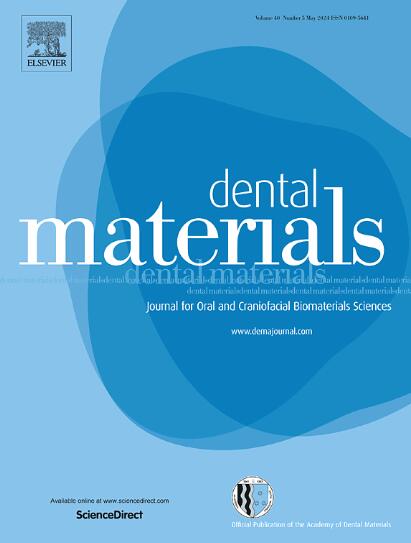Development of TiF4-Dendrimer complex gel as an anti-demineralization agent for dentin: An in vitro study
IF 4.6
1区 医学
Q1 DENTISTRY, ORAL SURGERY & MEDICINE
引用次数: 0
Abstract
Objective
The anti-caries effects of titanium tetrafluoride (TiF4) are well-documented, but its low pH challenges clinical application. This study evaluated PEG-citrate dendrimer as a carrier to enhance TiF4 stability and efficacy.
Methods
PEG-citrate dendrimer and TiF4-dendrimer gel were synthesized, and their structures confirmed using Fourier Transform Infrared Spectroscopy (FTIR), Hydrogen Nuclear Magnetic Resonance (1H NMR), and Liquid Chromatography–Mass Spectrometry (LC-MS). Thirty-six intact human teeth were prepared, randomly divided into three groups (n = 12) and subjected to pH cycling with the following treatments: titanium tetrafluoride (T), dendrimer (D), and dendrimer with TiF4 (TD). Vickers microhardness and Raman spectroscopy evaluated dentin demineralization. EDS analysis measured titanium and fluoride penetration into dentin in T and TD groups and mineral content (calcium and phosphorus) in all groups.
Results
The T group showed the highest microhardness loss (p < 0.001), followed by D and TD groups. EDS analysis revealed no significant difference in titanium and fluoride content between the surface and subsurface in TD (p = 0.344), while T had more titanium on the surface (p < 0.001). TD had higher subsurface calcium content compared to T (p = 0.008). Raman spectroscopy revealed significant changes in phosphate-to-amide and carbonate-to-amide ratios before and after pH cycling in all groups (p < 0.001), with no statistical differences among the groups.
Conclusion
Using dendrimer as a carrier for TiF4 increased pH and enhanced TiF44 ability to limit dentin demineralization and microhardness loss.
Clinical Relevance
The application of the newly-developed TiF4-dendrimer gel might be an effective approach to prevent/ limit dentin demineralization and dentin caries.
牙本质抗脱矿剂tif4 -树突状络合物凝胶的研制:体外研究。
目的:四氟化钛(TiF4)具有良好的抗龋作用,但其较低的pH值给临床应用带来了挑战。本研究评估了peg -柠檬酸树突状物作为载体增强TiF4的稳定性和功效。方法:合成peg -柠檬酸枝状大分子和tif4枝状大分子凝胶,采用傅里叶变换红外光谱(FTIR)、氢核磁共振(1H NMR)和液相色谱-质谱(LC-MS)对其结构进行确证。制备36颗完整人牙,随机分为3组(n = 12),分别采用四氟化钛(T)、树突状分子(D)和树突状分子加TiF4 (TD)进行pH循环处理。维氏显微硬度和拉曼光谱评价牙本质脱矿。能谱分析测量了T组和TD组中钛和氟对牙本质的渗透,以及所有组中矿物质(钙和磷)的含量。结果:T组牙本质的显微硬度损失最大(p)。结论:树突状分子作为TiF4载体增加了pH值,增强了TiF44抑制牙本质脱矿和显微硬度损失的能力。临床意义:新开发的tif4树突凝胶的应用可能是预防/限制牙本质脱矿和牙本质龋的有效途径。
本文章由计算机程序翻译,如有差异,请以英文原文为准。
求助全文
约1分钟内获得全文
求助全文
来源期刊

Dental Materials
工程技术-材料科学:生物材料
CiteScore
9.80
自引率
10.00%
发文量
290
审稿时长
67 days
期刊介绍:
Dental Materials publishes original research, review articles, and short communications.
Academy of Dental Materials members click here to register for free access to Dental Materials online.
The principal aim of Dental Materials is to promote rapid communication of scientific information between academia, industry, and the dental practitioner. Original Manuscripts on clinical and laboratory research of basic and applied character which focus on the properties or performance of dental materials or the reaction of host tissues to materials are given priority publication. Other acceptable topics include application technology in clinical dentistry and dental laboratory technology.
Comprehensive reviews and editorial commentaries on pertinent subjects will be considered.
 求助内容:
求助内容: 应助结果提醒方式:
应助结果提醒方式:


